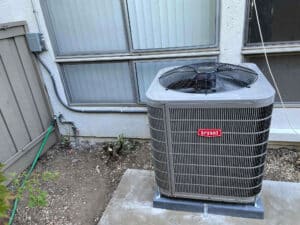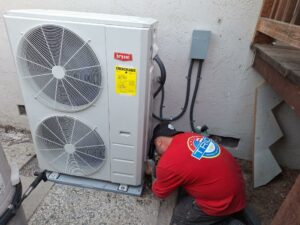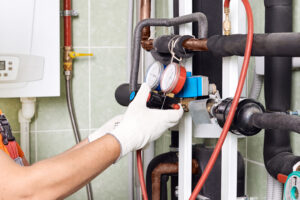Essential AC Maintenance Tips To Keep Your System Running Smoothly
With summer highs averaging 70°F, a reliable air conditioner is key to living comfortably in the Bay Area. Regular AC maintenance helps your system run smoothly, keeping your home cool while avoiding costly repairs.
Explore essential AC maintenance tips, learn ways to improve AC efficiency, and discover signs it’s time for professional AC maintenance from the expert team at TRIO.

Why Regular AC Maintenance Matters
Regular AC maintenance is a reliable way to keep your air conditioner running efficiently. Schedule a professional AC check-up at least once a year, ideally in the spring before the heavy-use season begins. In addition to cleaning the system to ensure it runs smoothly, professional maintenance also helps identify and address small problems before they become costly breakdowns.
Top AC Maintenance Tips Every Homeowner Should Know
Wondering how to maintain your AC unit? These seasonal AC maintenance tips help improve AC efficiency and reduce the risk of air conditioner breakdowns.
Change Filters Regularly
ENERGY STAR recommends checking your AC filters at least once a month and changing them at least every three months. Particularly during the heavy-use season, you may need to change your filters more frequently, so monthly inspections are important to assess the amount of buildup on the filter.
Clean the Condenser
The outdoor condenser unit pulls outside air into your system, but it can also pull in dust, dirt, and other debris. While smaller particles are caught in the air filters, larger items may clog the air intake on the condenser. Improve AC airflow by regularly inspecting the condenser, removing leaves and debris, and gently washing the unit with water and mild soap.
Protect the Unit During the Off-Season
Bay Area winters are typically mild, but it’s still a good idea to protect your AC when not in use. If you don’t use the system during the winter, consider turning it off and placing a cover over the outdoor unit to protect it from rain, dust, and debris.
Seasonal AC Maintenance Checklist
When your AC pro performs seasonal AC maintenance, they’ll typically follow an air conditioner maintenance checklist:
- Check, clean, or change air filters.
- Inspect the outdoor unit.
- Clean indoor and outdoor condenser coils.
- Check refrigerant levels.
- Inspect all electrical connections.
- Clean and lubricate mechanical parts.
- Clear the condensate drain line.
How To Improve AC Efficiency at Home
Learning how to improve AC efficiency at home helps extend the AC’s lifespan, save you money, and keep your home more comfortable.
Choose the Right AC Size
Correct AC sizing is key to improving efficiency. If your unit is too large, it may short-cycle as it tries to maintain the proper temperature. If the unit is too small, it may run constantly and burn out the fans. A qualified AC pro can help you find the best size for your home and energy needs.
Use a Programmable Thermostat
One of the biggest energy drains for an AC system is running it when you’re not home. A programmable thermostat makes it easy to reduce AC use when you’re away and when overnight outdoor temperatures drop. A smart thermostat automatically adjusts to temperature and occupancy levels.
Maintain Proper Airflow
Furniture and other items in front of vents force your AC to work harder to move air through your home. Check for items blocking the indoor vents or the intake vent for the outdoor condenser unit.
Insulate the System
Even if your AC unit is functioning properly, cold loss can still occur through your coolant lines, vents, and other components of the system. Make sure AC lines are insulated to minimize energy loss and inspect for leaks in your vents or other areas where air may escape.
Insulating your home and using Energy Star efficient windows help reduce energy loss and may even qualify you for energy rebates, depending on local legislation.

Signs Your Air Conditioner Needs Maintenance
If you notice any of the following signs, it’s time to call for routine AC service.
Loud Noises
When your air conditioning system is running properly, it usually produces a quiet, consistent sound. However, an air conditioner in need of maintenance may make loud and unusual noises, such as clanging, whirring, whining, or clunking. If your AC makes odd or new noises, it’s a sign to call for an AC inspection.
Bad Smells
A broken AC may produce a musty, burning, or sweet, chemical-like smell. Musty smells usually indicate mold or mildew, which can affect indoor air quality and should be cleaned out by a professional.
A burning or chemical smell needs immediate attention. Burning usually means a fire hazard, while a chemical smell can indicate a toxic refrigerant leak. If you smell either of these things, turn off your AC, evacuate the home, and call a pro for repairs.
AC Turning Off and on Again
A typical AC cycle includes about 15 to 20 minutes on, followed by about 15 to 20 minutes off. Depending on your unit and the temperature in your home, this may be slightly shorter. However, if your AC is turning rapidly on and off (with cycles lasting less than 10 minutes), this can indicate AC short cycling and means the unit is due for inspection.
Rising Energy Bills
If you’ve noticed a jump in your utility costs, it’s a good sign that it’s time for AC maintenance. A gradual rise may indicate wear and tear, while a sudden spike can mean a broken component. Maintenance can help get your energy bill back where it belongs.
The Benefits of Scheduling Professional AC Tune-Ups
There are many benefits to professional AC tune-ups, including reducing AC repair costs, boosting home safety and indoor air quality, and extending AC lifespan.
Avoid Costly Repairs
Unaddressed AC issues can quickly escalate into more significant problems, resulting in costly repairs. Calling an AC pro at the first sign of a problem is the best way to prevent a major AC breakdown and keep your home cool.
Improve Home Safety
While air conditioners are generally very safe, even the best units can become a problem when worn or damaged. Regular AC maintenance helps identify potential issues, such as fire hazards and refrigerant leaks, before they become a risk to your family. Routine cleaning and maintenance also help reduce mold and mildew, improving the air quality in your home.
Prolong AC Lifespan
Modern air conditioners typically have a lifespan of 15 to 20 years when well-maintained. Routine professional AC maintenance reduces wear and tear, helping you get the most out of your air conditioner.

Book an AC Maintenance Appointment With TRIO Heating, Air & Plumbing
Keep your AC running smoothly and avoid costly repairs with annual professional maintenance. Our team of licensed pros at TRIO Heating, Air & Plumbing provides expert tools and great customer service to your Bay Area home. Contact us today to book your next appointment and keep your air conditioner working at its best.
What To Include in Your Annual AC Maintenance Checklist
Summer temperatures in the Greater San Francisco Bay Area have been heating up in recent years, which means you need a reliable air conditioning system to keep you cool. Using a thorough annual AC maintenance checklist is one way to protect your investment and ensure reliable comfort.
The experts at TRIO Heating, Air & Plumbing provide reliable AC maintenance services to customers in the Bay Area. Explore some tips to help you keep an AC maintenance checklist that you can use every season.

Why Annual AC Maintenance Matters
Routine AC maintenance is important for many reasons. Here’s why sticking to a regular HVAC maintenance schedule matters.
Improves Energy Efficiency
A well-maintained AC system runs smoothly with good airflow, which helps it operate more efficiently. Not only is this great for your air conditioner, but it’s also better for the environment. Plus, when your AC runs efficiently, it helps you save money on your monthly energy bills.
Better Indoor Air Quality
Clean air filters and components don’t just help to preserve your AC system. This simple maintenance task also improves the air quality in your home by preventing airborne particles and contaminants from getting into the air. When your AC is free of dust and debris, the indoor air is much cleaner, keeping you and your family healthy.
Prevents Costly Repairs
Annual maintenance is one of the most effective ways to prevent AC breakdowns. A thorough inspection performed by the experienced team at TRIO can pinpoint minor problems early and get them repaired. The sooner you identify and correct less urgent issues, the less chance they’ll turn into costly repairs or a full system breakdown.
What Happens if You Skip AC Maintenance?
You might be tempted to skip AC maintenance to save time and money, but it can lead to a variety of issues. Some risks of skipping your AC maintenance routine include:
- System runs less efficiently: A poorly maintained AC system won’t run as efficiently as it should, which may lead to higher energy bills during the summer.
- Potential breakdowns: Without annual AC maintenance service, your system runs the risk of breaking down, forcing you to schedule an emergency repair.
- Shorter lifespan: Regular maintenance extends the service life of your system, and without it, you run the risk of having to pay for a full system replacement.
- Voided warranty: Many air conditioner brands require you to schedule regular maintenance to keep the warranty active and valid.

Complete AC Maintenance Checklist for Homeowners
Following an air conditioner maintenance checklist is a smart way to make sure your system gets the routine care it needs. Consider these helpful AC tune-up tips to get the most out of your air conditioner:
- Check and replace filters: Replace your AC filter every 30 to 90 days. Checking the filter for debris and dirt regularly and changing it as needed is the best way to support good airflow and energy efficiency.
- Clean the indoor unit: Clean your indoor unit, including the evaporator coil, with a soft, clean cloth to prevent excess buildup.
- Monitor the thermostat: Make sure your thermostat’s temperature matches the temperature inside your home. If it doesn’t, you may need an inspection or repair.
- Clean the condenser unit: Clean your outdoor condenser unit and remove debris from the surrounding area to protect it from damage.
- Inspect the insulation: Insulation around the AC’s copper piping maintains thermal efficiency. If it’s damaged or missing and needs to be replaced, contact TRIO right away.
- Schedule routine maintenance: The best way to protect your air conditioner is to schedule maintenance performed by professionals at least once a year.
How AC Tune-Ups Improve Performance and Efficiency
One of the biggest benefits of AC maintenance, including tune-ups, is improved performance and efficiency. Tune-ups help your system perform as efficiently as possible in the following ways.
Keeps Important Components Clean
A routine tune-up includes cleaning major components like the evaporator coil. Keeping these parts clean preserves lifespan and supports better airflow for a more efficient system.
Monitors Refrigerant Levels
Refrigerant leaks and low refrigerant levels are a common cause of AC malfunction. A routine inspection and tune-up lets you know if your air conditioner is leaking refrigerant. If levels are low, a technician will refill the refrigerant to keep the system running smoothly.
Ensures Maximum Efficiency
The best way to achieve AC efficiency improvement is with routine professional maintenance. From lubricating components and cleaning or changing the air filter to monitoring refrigerant levels, an annual AC tune-up gives your system the care it needs to run as reliably as possible when temperatures climb.
The Benefits of Professional AC Maintenance Services
Scheduling professional AC maintenance services comes with a range of benefits that make getting these services well worth the cost:
- Peace of mind: Professional AC maintenance gives you peace of mind knowing you’re protecting your investment and helps you receive reliable cooling all summer long.
- Addresses issues early: Maintenance performed by an experienced HVAC technician is the best way to identify and address minor issues early before they turn into expensive and stressful repairs.
- Keeps indoor air clean: Professional maintenance keeps the air inside your home clean thanks to regular filter changes and cleaning of important components that could lead to dirty indoor air if clogged or blocked.
- Helps maintain property resale value: When your AC is well-maintained, it protects not just the value of your system, but also the value of your home as a whole.
When To Consider Replacing Your AC Unit
While routine maintenance is key to keeping your AC running smoothly, there are times when you’ll need a replacement. Look for these signs indicating the need for AC maintenance or replacement:
- System age: Air conditioners that are 10 to 15 years old or older may be near the end of their lifespan, and a replacement could be a better option.
- Frequent repairs: If you’re paying for frequent repairs, it might be more cost-effective to upgrade to a new AC unit.
- High energy bills: When your summer energy bills suddenly skyrocket, there’s a good chance it’s related to a failing or malfunctioning AC system.
- Loud noises: Unusual noises or vibrations coming from your AC unit are a sign that something is wrong, and a full replacement may be recommended.

Contact TRIO for Your Annual AC Maintenance
If you live in the San Francisco Bay Area, annual maintenance is the best way to protect your system and keep you cool. The experts at TRIO Heating, Air & Plumbing proudly provide professional maintenance services for optimum performance. Contact us today to schedule your annual AC maintenance service!
How Heating Maintenance Can Improve Your System’s Lifespan
Your heater works hard to keep your home warm throughout the chilly Bay Area winters. However, wear and tear can cause its lifespan to fall short without regular upkeep. Routine tune-ups help catch minor issues before they become more significant problems, boost efficiency, and keep everything working correctly so you can enjoy cozy comfort for years to come. Read on to discover how regular heating system maintenance improves your unit’s lifespan and keeps your home warm and worry-free all winter long.

Why Heating Maintenance Matters
Like any home system, your heater needs regular upkeep to keep everything running smoothly. When you schedule professional heating maintenance, a certified technician inspects, cleans, and tunes up your unit from top to bottom. They check that all parts are working correctly, look for potential hazards, and identify minor issues before they progress. These tasks improve your unit’s efficiency, prevent heating repairs, increase its lifespan, and keep your home safe and warm through the chilly winter months.
Key Benefits of Regular Heating Maintenance
Keeping up with regular heating maintenance offers several benefits that improve home comfort, lower bills, and keep your household safe. By taking care of your system, you’ll avoid unexpected breakdowns, improve energy efficiency, and extend its lifespan. Some of the top perks you’ll see include:
- Lower energy bills: A well-maintained heater uses less energy to warm your home, reducing your utility bills and carbon footprint.
- Fewer repairs: During your heating tune-up, the technician will look for and fix any minor issues before they become bigger, more costly problems.
- A safer household: Regular maintenance helps minimize the risk of dangerous carbon monoxide leaks or electrical issues.
- A longer system lifespan: Routine maintenance prevents excessive wear and tear, helping your heater run for years to come.
- Consistent home comfort: With your heater running smoothly, you won’t have to worry about uneven temperatures, poor airflow, or breakdowns keeping you in the cold.
Signs Your Heating System Needs Maintenance
It’s important to schedule a heating system checkup at least once a year to keep your unit running in top condition. If it’s been over a year since your last heating service or you can’t seem to remember when your last service was, it’s a good idea to schedule maintenance. Some other key signs that your heater is overdue for a tune-up include:
- Rising energy bills: A poorly maintained heater uses more energy to warm your home, causing your heating bills to increase.
- A yellow pilot light: Your furnace pilot light should always be bright blue. If it looks yellow, there may be a carbon monoxide leak that requires immediate service.
- Excess dust near the vents: Unchanged or dirty filters cause dust to build up around the vents, decreasing indoor air quality and blocking airflow.
- Strange noises: Grinding, rattling, or banging noises can indicate internal issues that need attention.
- Inefficient heating: If your house takes forever to warm up, your heater may struggle to function due to wear and tear.
- Strange odors: Burning or other foul odors from your heater often indicate dust buildup or mechanical issues requiring service.
How Maintenance Helps Extend Your System’s Lifespan
While most heating systems last 10 to 15 years, regular maintenance can help your unit reach and even exceed this lifespan. Regular upkeep, such as lubricating moving parts, tightening connections, and performing other key tasks, keeps your heater in top condition while reducing wear and tear. By limiting the strain on your system, you’ll boost its lifespan and prevent the need for costly repairs or early replacement.

DIY vs. Professional Heating Maintenance
When it comes time for your annual heating tune-up, you may be tempted to do the job yourself. While you can perform a few DIY tasks to keep things running smoothly until your next service, heating maintenance should always be left to the professionals.
Certified HVAC technicians have the skills and experience to perform a comprehensive maintenance checklist, ensuring that all components receive a thorough inspection, cleaning, and tune-up. They can also spot worn-out or failing components that an untrained eye might overlook, helping to prevent more significant, costly issues.
With a professional service, you can rest easy knowing that your heater is in optimal condition, free from safety hazards, and running efficiently for years.
How Often Should You Schedule Heating Maintenance?
It’s important to schedule maintenance at least once a year to prevent breakdowns and keep your heater running efficiently. The best time to book your tune-up is in late summer or early fall before peak heating season begins. This timing helps prepare your heater for the cold winter temperatures ahead.
With a full inspection of your unit during this time, you won’t have to worry about unexpected breakdowns or major issues impacting your home comfort. The technician will catch and repair any minor problems, preventing them from progressing into major repairs. With annual maintenance, you’ll improve your unit’s efficiency and extend your HVAC’s lifespan, keeping your home warm and cozy for many winters ahead.
Call TRIO to Schedule Professional Heating Maintenance Today!
Keep your home warm and cozy for years with professional heating maintenance from the team at TRIO. Our experts offer five-star furnace tune-ups throughout the Greater San Francisco Bay Area that extend your HVAC’s lifespan, improve energy efficiency, and prevent costly repairs. Don’t wait for a breakdown to schedule service. Call our team to book your annual tune-up today!
Want to take your heating maintenance to the next level? Join our maintenance Membership Program to receive bi-annual 29-point HVAC tune-ups, priority service, and other VIP benefits.
The Importance of Annual Heating Maintenance: Preparing for the Chill Ahead
Heating maintenance is preventative care that includes a full heating system inspection, cleaning, and even small repairs. It’s good for every home, and homeowners should schedule their heating maintenance appointment in the fall before the cold weather hits.
TRIO Heating, Air, & Plumbing is available to service your home heating system so you can rest easy knowing your heater will keep your family warm all winter long. We’re San Francisco locals, so we understand how the winter chill can set into your home. You need a furnace that works well — we’re here to help ensure your heating system always runs at peak performance.
The Importance of Annual Heating Maintenance
Annual heating maintenance is the best way to keep your furnace running at peak performance. It allows your professional HVAC technician the chance to look over the entire system and find and fix any small issues before they become a big deal. This can save your furnace from catastrophic failure mid-winter and help prevent thousands of dollars in repairs or replacement costs.
Annual heating maintenance is crucial for the longevity of your heating system. In some cases, scheduling annual heating maintenance calls can make all the difference between your furnace lasting only eight years or more than twenty.
Cleaning out grime and fixing small issues reduces wear and tear and keeps your heating system running efficiently. A clean furnace uses less power or fuel to do its job, saving you on your energy bills and reducing your home’s environmental impact, even if your furnace is on 24/7.
Consequences of Skipping Heating Maintenance
What happens if you ignore your furnace and don’t maintain your heating system? If you skip heating maintenance, blast the heat all winter long, and hope for the best, you’ll likely notice your furnace starting to have difficulty maintaining a consistent temperature in your home. It might be cold in one room and hot in another, or the furnace will turn on and off quickly without thoroughly heating the space.
You may also notice bad smells from your vents and more dust around the house. Your indoor air quality might worsen, with more allergens, pollen, and mold spores getting dispersed through the vents.
Over time, smaller problems like a loose belt or faulty valve can become big issues requiring extensive (and costly) repairs. Your furnace may even fail, leaving you in the cold. Depending on the weather, this can also lead to burst pipes in your home.
If you have a gas furnace, neglecting maintenance is dangerous. A small issue can grow until it causes a gas leak, and your furnace may become a fire hazard over time if certain internal systems fail.
If you never have your furnace professionally maintained, you may be in danger of voiding your HVAC system’s warranty. Most mandate that the service life of the furnace depends on regular tune-ups.
Key Steps for Preparing Your Heating System for Winter
If you keep a winter checklist for home maintenance, make sure to include the following heating system preparation steps:
- Do a filter check, and replace or wash the filter if it’s been in place for over 90 days or looks dirty.
- Test your thermostat by turning on the heat, then slowly raising the temperature in five-degree increments. If the furnace doesn’t quickly kick on and start heating the home, you may need an expert to find the issue.
- Look for water leaks around the furnace. This is a common problem with high-efficiency models, and the water can damage the furnace or even cause mold to grow in your house if it’s not addressed. Call an HVAC professional to fix the leak.
- Listen closely to the furnace when it’s on, and call an expert if it starts making squeaking, clicking, squealing, banging, or booming sounds. These can indicate small problems or dangerous issues, so addressing them quickly is a good idea.
If you have a gas furnace, you should also have the pilot light, flame sensor, and gas lines checked out by an expert to ensure your system is safe.
Benefits of Professional Heating Maintenance Services
The benefits of hiring TRIO for heating maintenance include:
- Improved home comfort and safety, with efficient heat all winter long
- Less stress, knowing your heating system is working at its best
- Lower heat bills and fewer costly repairs
- Better air quality, with fewer allergens, mold spores, and other nasty particulates in the air you and your family breathe
- Staying within the terms of your furnace’s warranty
- Trustworthy service — you can count on us to show up on time with good quality parts
How Annual Maintenance Saves You Money in the Long Run
One of the biggest heating maintenance benefits is the money you’ll save. Keeping your furnace running at its best means you’ll have more efficient heating throughout your home, better air quality, and lower energy bills.
HVAC maintenance is necessary to prolong the service life of your furnace and keep you on good terms with the unit’s warranty.
When It’s Time to Upgrade Your Heating System
Unsure if it’s time to upgrade your heating system to a newer model? Here are some of the biggest signs it’s time to replace your current system:
- Uneven heat throughout your home or no heat coming from the vents at all
- Higher-than-usual energy bills as the furnace starts running less efficiently
- Your furnace is over 10 years old
- Loud noises when the furnace is running, including rattling, popping, screeching, or humming.
- Issues starting up, like when a gas furnace doesn’t ignite the gas properly
- Parts are harder to find because the furnace model is outdated
- Repair bills are getting out of hand
Installing a new furnace may be less expensive than repairs in the long term. It’s better to upgrade your furnace before it possibly breaks down in the dead of winter. In that case, you may be without heat until a technician can do the replacement, leaving you vulnerable to burst pipes and discomfort in a cold house.
A new furnace also comes with plenty of benefits, like programmable thermostat options, smart-home integration, and fast, efficient heating you’ll love.
Contact TRIO for Your Annual Heating Maintenance
TRIO is here to provide annual heating maintenance and any other services you need for your HVAC system. Contact us today to schedule an appointment and we’ll show you why we’re known for providing the top heating and air services in the Greater San Francisco Bay Area. Book your annual heating maintenance appointment now so you can be confident that your home heat system is in peak condition when the temperature drops.
Winter Heating Maintenance Checklist: Keep Your System Running Smoothly
As the winter chill sets in across the San Francisco Bay Area, your home’s heating system must be ready to keep your family warm and comfortable. At TRIO Heating, Air & Plumbing, we understand that proper heating maintenance is crucial for ensuring your safety and peace of mind, especially during the coldest months of the year. Follow this comprehensive guide to walk through everything you need to know about winter heating maintenance, helping you keep your HVAC system running smoothly and efficiently all winter.
Importance of Winter Heating Maintenance
Regular heating maintenance is more than just a recommended practice — it’s essential for the longevity and performance of your home’s HVAC system. Preventative maintenance helps to identify and remedy issues that may otherwise lead to unexpected breakdowns. It also improves energy efficiency and can save you significant money in the long run.
A well-maintained heating system:
- Reduces the risk of costly emergency repairs
- Improves overall energy efficiency
- Extends the service life of your heating equipment
- Ensures consistent and reliable performance
- Maintains optimal indoor air quality
Signs Your Heating System Needs Immediate Attention
Before winter reaches its peak, watch out for these critical red flags that may indicate your home’s heating system requires professional attention:
- Unusual noises, like banging, rattling, or squealing sounds
- Inconsistent heating, resulting in cold spots or uneven heating across different rooms
- Spikes in heating costs, pointing toward possible system inefficiency
- A heating system that frequently turns on and off for no apparent reason
- Unpleasant odors may indicate mold, mildew, gas leaks, or faulty electrical components
Winter Heating Maintenance Checklist: Step-by-Step Guide for DIY Tasks
While professional inspections and service are crucial, homeowners can follow these heating system maintenance tips to keep their HVAC working at its best.
Air filter maintenance
Regularly replacing or cleaning air filters is one of the easiest and most important DIY heating maintenance tasks. Dirty filters restrict airflow, reduce system efficiency, and can cause unnecessary strain on your heating system.
For most homes, replace disposable filters every few months or clean reusable filters once every month or two. Mark your calendar or set a reminder to ensure you don’t forget this step, particularly as part of your winter heating preparation routine.
Outdoor unit care
If you have any HVAC components that are outside of your home, be sure to keep the area around it clear of debris, leaves, branches, and snow. Maintain at least a two-foot clearance around the unit to ensure proper airflow and prevent potential damage. During winter, remove any snow or ice buildup carefully, avoiding direct contact with delicate components.
Seal and insulate
Conduct a thorough check of all windows, doors, and other potential sources of air leaks. Use weatherstripping, caulk, or draft stoppers to seal any gaps that could let warm air escape. Pay special attention to areas around window frames and door thresholds. Proper sealing reduces your heating system’s workload and thus lowers your energy bills too.
Vent, register, and grille maintenance
As a homeowner, a regular part of your winter heating preparation checklist should include checking all air vents and registers to ensure they are completely unobstructed by furniture, rugs, or curtains. Vacuum these areas regularly to remove dust and debris that can impede airflow. Use a soft brush attachment to clean vent covers and remove dust.
Professional Heating Maintenance Checklist
Our expert heating technicians offer a comprehensive heating maintenance service. To keep your HVAC system operating at an optimal level, we recommend scheduling a heating maintenance call at least once a year. This can identify some of the most common heating system problems in winter, like malfunctioning thermostats, pilot light issues, dirty air filters, clogged air filters, duct leaks, and burning smells.
Thorough system inspection
Our technicians meticulously examine every critical component of your heating system. We carefully check for signs of wear and tear, inspect electrical components for potential hazards, and assess overall system performance. This detailed evaluation identifies potential issues before they become major problems.
Cleaning and optimization
Our cleaning service goes far beyond a simple surface wipe-down. To help maintain your heating system’s peak efficiency, we clean burners and heat exchangers, removing built-up dust, debris, and potential corrosion. We lubricate all moving parts to reduce friction and wear, which can significantly extend your system’s lifespan. Air filters are cleaned or replaced, as needed, as the thermostat is precisely calibrated.
Safety checks
Safety is our top priority. We check carbon monoxide levels, verify gas pressure and connections, and inspect the heat exchanger to look for any cracks or damage that could compromise system safety. We also verify proper ventilation to prevent any potential safety risks.
Performance testing
As part of the regular heating maintenance checklist, our technicians measure the efficiency of your system, including airflow and temperature differentials, heating cycle operation, and energy consumption. We check for any irregularities in startup, running, and shutdown processes, ensuring your heating system operates reliably throughout the winter months in the San Francisco Bay Area.
Benefits of Scheduling Professional Heating Maintenance
Investing in professional heating maintenance is crucially important for several reasons:
- Enhanced efficiency: A well-maintained heating system can improve energy efficiency, directly lowering your monthly utility bills.
- Preventative care: Detailed inspections can reveal potential issues before they become major problems requiring costly repairs or replacement.
- Extended system life: Regular maintenance can add years to your heating system’s usable lifespan.
- Improved comfort: Ensure consistent, reliable heating throughout your home all year round.
When to Replace Your Heating System
It’s never easy to decide that you need to replace your home’s heating system. It’s a decision that requires careful consideration. In most cases, age is one of the biggest factors. Most heating systems have an optimal lifespan of 15 to 20 years. However, age alone isn’t the only indicator. You must pay close attention to your system’s performance, efficiency, and repair frequency.
If you find yourself facing increasingly frequent and expensive repairs, it may be a more cost-effective choice to invest in a new, energy-efficient system. Rising energy bills, despite regular maintenance, can also signal it’s time to consider a replacement. Modern heating systems offer significant improvements in technology, energy efficiency, and overall home comfort.
Schedule Your Winter Heating Maintenance Today!
Don't let the winter catch you unprepared. Protect your home, ensure your comfort, and save money with TRIO Heating, Air & Plumbing 's professional heating maintenance services.
Call TRIO Heating, Air & Plumbing today at (415) 226-4125 or contact us online to schedule your professional heating maintenance service! We promise prompt customer service and are dedicated to delivering superior work with every job.
8 Essential DIY Heating Maintenance Tips
Aside from an annual tune-up, the HVAC professionals at TRIO Heating, Air & Plumbing recommend various DIY heating maintenance steps. Heating accounts for a significant portion of your home utility costs. Therefore, it’s important to keep your heater in top shape. You don’t need to be a heating service contractor or have one with you at all times; the following heating maintenance tips ensure your furnace is safe to operate, keeps your home warm, and runs at peak efficiency:
Replace or Clean the Air Filter
Clear Any Clutter Around Your Furnace
Vacuum the Supply and Return Vents
Check that the Burner Flame Is Blue
Adjust the Dampers Seasonally
Replace the Batteries on Your Thermostat and Carbon Monoxide Detector
Check for Vent or Chimney Blockages
Clean Your Whole-House Humidifier
1. Replace or Clean the Air Filter
Replacing or cleaning the air filter is one of the easiest heating maintenance tasks. Check the owner’s manual for its location, how to access it, and what type and size you need. The correct size may be labeled on the filter. Or, you can measure it to find one with the same dimensions. Also, make sure the filter’s efficiency rating is compatible with your heating system.
Remember to replace the main air filter and any filters in the air intake or blower. Generally, filters should be cleaned or replaced every one to three months. However, this depends on their type and quality and heater usage. A clean filter can improve your furnace’s efficiency and increase its lifespan.
2. Clear Any Clutter Around Your Furnace
The area surrounding your furnace should be clear. Storage boxes, containers, cleaning supplies, tools, toys, and other belongings can restrict airflow and make it harder to access your heating system. Cleaning the clutter helps a technician more easily service the unit and its components. It can also help your furnace work more efficiently.
3. Vacuum the Supply and Return Vents
Registers and vents move a lot of air and can collect dust in the process. If not cleaned, they can become blocked, restricting airflow. A lack of airflow can cause reduced heat production, uneven heating, or less air to get to your furnace, which can cause it to perform less effectively. Increased strain can also damage your heating system.
To avoid trouble, regularly check supply and return vents for dust and blockages. Dust can be brushed or vacuumed away. If any furniture, boxes, cabinets, or toys are blocking vents, move these items to another location so air can flow freely.
4. Check that the Burner Flame Is Blue
The burner flame may be visible through a small glass window or you may have to turn off the furnace and open the cover. The burner flame, or flames, depending on your furnace, should be a vibrant blue hue. A yellow or orange flame is a sign of a combustion problem. It can also mean your heater is leaking carbon monoxide.
Do not attempt to clean, adjust, or repair furnace burners yourself. Contact a professional who’s equipped to safely repair the unit, avoid hazards, and prevent further issues.
5. Adjust the Dampers Seasonally
If the same ductwork serves your heating and cooling systems, it may have dampers. These should be adjusted for each season. This way, the damper on the supply trunk can allow more warm air to lower levels in winter and more cold air upstairs in the warmer months.
To adjust the dampers, follow the markers on them, the duct walls, or a nearby control. The proper adjustments improve heating system efficiency and avoid performance issues.
6. Replace the Batteries on Your Thermostat and Carbon Monoxide Detector
If it’s battery-operated, a thermostat won’t work properly if its power source is drained. Your heating system can also malfunction. Changing the batteries once a year can prevent issues. The carbon monoxide detector’s batteries should also be changed. While this won’t affect furnace performance, it’ll alert you of a toxic gas leak caused by a potential furnace problem.
7. Check for Vent or Chimney Blockages
The chimney flue vents toxic gases produced during the combustion process. Holes, gaps, or blockages can prevent carbon dioxide and other gases from exiting your home. Check the connection between the flue and furnace for damage and outside vents where vegetation, animal nests, snow, and debris can cause blockages. Clearing debris can avoid indoor air quality and furnace performance issues.
8. Clean Your Whole-House Humidifier
If your HVAC system has a whole-house humidifier, it must be properly maintained. First, determine what type of humidifier you have. The two types often used in homes include the following:
- Evaporative Humidifier: An evaporative humidifier has a pad that soaks up water; this pad must be replaced at least once a year. After you remove the old pad, wipe the interior of the humidifier cabinet to ensure it’s dry, and use a vinegar solution to remove dirt and mineral deposits from the water supply and drain lines.
- Steam Humidifier: A steam humidifier boils water to increase indoor humidity. To maintain it, turn off the humidifier and wait for it to complete a drain cycle. Remove the overflow pan and tank; clean them with a vinegar solution. Then remove the O-ring from the tank and clean the orifice. The O-ring should be replaced if it’s worn or damaged.
Heating Maintenance Tasks You Should Not Do Yourself
Do not perform any task that requires accessing the interior of your furnace. You risk causing damage to sensitive components. For example, many DIY help guides explain how to clean the combustion chamber, burners, flame sensors, blower, etc. These should always be free of buildup. However, only a well-trained, properly equipped professional should attempt to clean them.
Also, call an HVAC company if you notice issues such as a cracked heat exchanger, corroded parts, excessive soot, irregular flames, short cycling, a leak, or unusual odors.
Contact TRIO Heating, Air & Plumbing
When you need a furnace tune-up, we provide high-quality work and can service any brand or model. Customers in The Greater San Francisco Bay Area rely on us to keep their heating systems in top shape. Our technicians are professionally trained, knowledgeable, and courteous while being committed to ensuring your home is safe and comfortable. To schedule heating maintenance, book your appointment or call (415) 226-4125 today.
